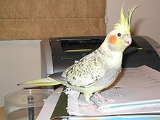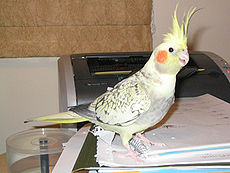
Cockatiel colour genetics
Encyclopedia

Genetics
Genetics , a discipline of biology, is the science of genes, heredity, and variation in living organisms....
deals with the heredity
Heredity
Heredity is the passing of traits to offspring . This is the process by which an offspring cell or organism acquires or becomes predisposed to the characteristics of its parent cell or organism. Through heredity, variations exhibited by individuals can accumulate and cause some species to evolve...
of colour variation in the feathers of the bird species commonly known as the Cockatiel
Cockatiel
The Cockatiel , also known as the Quarrion and the Weiro, is the smallest cockatoo endemic to Australia. They are prized as a household pet and companion parrot throughout the world and are relatively easy to breed...
, (Nymphicus hollandicus). About fifteen primary colour mutation
Mutation
In molecular biology and genetics, mutations are changes in a genomic sequence: the DNA sequence of a cell's genome or the DNA or RNA sequence of a virus. They can be defined as sudden and spontaneous changes in the cell. Mutations are caused by radiation, viruses, transposons and mutagenic...
s have been established in the species and enable the production of many different combinations.
Note :
aka stands for also-known-as,
cka stands for commonly-known-as
& ika stands for incorrectly-known-as
- ADMpied (aka Recessivepied aka Harlequin)
- Ashenfallow (ika Recessive Silver)
- Bronzefallow (cka Brownfallow)
- Cinnamon
- Dilute (ika Pastel Silver)
- Dominant silver (aka Ashen Dilute)
- Edged dilute (ika Spangled ika spangled silver)
- Faded
- SL Ino
- Albino
- NSLino (Recessive Ino)
- Opaline (cka Pearled)
- Palefaced (ika Pastelfaced)
- Platinum (ika Pallid)
- Whitefaced (same gene as genuine Blue mutation in typical Parrot and Parakeet species)
- Dominant and Sex-Linked Yellowcheeked
- Yellow-suffused (ika Emerald, or Olive)
The multiple names for these mutations is due in part to different regions of the globe naming the same colour change a different term. This does not mean that it is a different mutation. It only means it is a different name.
Colour mutations are a natural but very rare phenomenon that oddly occur in either captivity or the wild.
The "Normal Grey" or "Wild-type" cockatiel's plumage
Feather
Feathers are one of the epidermal growths that form the distinctive outer covering, or plumage, on birds and some non-avian theropod dinosaurs. They are considered the most complex integumentary structures found in vertebrates, and indeed a premier example of a complex evolutionary novelty. They...
is primarily grey with prominent white flashes on the outer edges of each wing
Wing
A wing is an appendage with a surface that produces lift for flight or propulsion through the atmosphere, or through another gaseous or liquid fluid...
. The face of the male is yellow or white, while the face of the female is primarily grey or light grey, and both genders feature a round orange area on both ear areas, often referred to as "cheek patches." This orange colouration is generally vibrant in adult males, and often quite muted in females. Visual sexing is often possible with this variant of the bird.
"Whiteface" cockatiels have their yellow pigments deactivated by an autosomal recessive gene, resulting in a cock with a truly white face and a hen with a more typical mottled grey face.
This means, there is no yellow or orange colouring in a whiteface cockatiel.
The "Lutino" sex-linked recessive mutation is a perfect example of a type of cockatiel that are the hardest to sex visually. Lutinos lack eumelanin pigment (enabling black, brown, grey colours and tones) and are consequently yellow to yellowish-white with orange cheek-patches. Adult female Lutinos as well as immature Lutinos of both genders display yellow bars, dots and/or stripes on the underside of their tail feathers. While mature males always display solid white coloured undersides of tail-feathers.
Unfortunately, a good number of Cockatiels of all Ino mutations and varieties (Albino ika Whitefaced Ino, Palefaced Ino aka Creamino, Lutino, Opaline-Ino aka Pearlino, etc.) are usually affected with a transmittable genetic flaw monstrously enlarging the bald-spot below the crest, due to irresponsible excessive in-breeding and a general lack of effort, ethics & responsibility breeders to breed it out.

It is important to know that, throughout Parrot species the ADMpied (AntiDiMorphic Pied) gene negates the male's ability from ever displaying his species' dimorphic features. Leading to ADMpied cockatiels being notoriously difficult to sex visually but being excellent examples for studies in genetic traits. However, in monomorphic species (i.e. Conures, Lovebirds, Macaws, Rosellas) the Anti-Di-Morphic (hence ADMpied) feature cannot be expressed but Piedness still is and in these species such Pied specimens are called either Recessivepied and/or Harlequin.
Cinnamon and Opaline ("Pearled") mutations are sex-linked recessive. In Cinnamons, the melanin pigment is modified in such a way that eumelanin pigments are stopped at the brown stage of their development to becoming black.
Here is an excellent description of the pearled cockatiel:
The Pearl Cockatiels gene does not have any visual affect on the colour pigments in the bird but instead it affects the distribution of the colours that are already present. It actually decreases the spread of the grey family of pigments (melanin) and increases the spread of the yellow pigments (psittacins). Individual feathers over most of a pearled bird will have more of the yellow family of pigments visible giving them a scalloped pattern.
It is especially interesting to note that males do not retain the pearled colourings. They soon lose this after their first molt. Though you may not be able to see this pattern, it is not essentially gone. It is only covered up by more grey pigment.
There are a tremendous number of colour varieties (combined mutations), including ADMpied Cinnamon, Albino (ika Whitefaced Ino), Opaline Cinnamon (aka Pearled Cinnamon), Palefaced Lutino (aka Creamino), Whitefaced Cinnamon and Whitefaced Opaline (Pearl).
The Albino (ika Whitefaced Ino) Cockatiel is the exact genetic equivalent of any other Albino combination mutation in other Parrot species such as the Budgerigar
Budgerigar
The Budgerigar , also known as Common Pet Parakeet or Shell Parakeet informally nicknamed the budgie, is a small, long-tailed, seed-eating parrot, and the only species in the Australian genus Melopsittacus...
, the celestial aka Pacific Parrotlet
Pacific Parrotlet
The Pacific Parrotlet , also known as Lesson's Parrotlet or the Celestial Parrotlet, is a species of small parrot in the Psittacidae family, native to Ecuador and Peru...
, the Indian-ringnecked aka Rose-ringed Parakeet
Rose-ringed Parakeet
The Rose-ringed Parakeet , also known as the Ringnecked Parakeet, is a gregarious tropical parakeet species that has an extremely large range. Since the trend of the population appears to be increasing, the species has been evaluated as Least Concern by IUCN in 2009.Rose-ringed parakeets are...
, the splendid aka Scarlet-chested Parrot
Scarlet-chested Parrot
The Scarlet-chested Parrot , known alternately as Scarlet-breasted parrot, Orange-throated parrot or Splendid parrot, is a parrot endemic to central South Australia and inland southern Western Australia...
and the white-eye-ringed Lovebird
Lovebird
A Lovebird is one of nine species of the genus Agapornis . They are a social and affectionate small parrot. Eight species are native to the African continent, while the Grey-headed Lovebird is native to Madagascar...
species. This mutation is always produced by combining the genuine Whitefaced mutation (otherwise called Blue mutation in all Lories, Lorikeet
Lorikeet
Lories and lorikeets are small to medium-sized arboreal parrots characterized by their specialized brush-tipped tongues for feeding on nectar of various blossoms and soft fruits, preferably berries. The species form a monophyletic group within the parrot family Psittacidae...
s and/or typical Parrot species) and Complete Albinistic (either NSLino and/or SL Ino) mutations together.
Mutations can appear both individually or in a wide variety of combinations such as Albino (ika Whitefaced Ino), Pearled Lutino (aka PearlIno), Whitefaced Pied and Opaline-Cinnamon (aka Pearled-Cinnamon). Still fairly hard to find is the rather new Yellow-suffused (ika 'Emerald and/or 'Olive') mutation. Cockatiels do not actually have green pigment to their plumage, thus Yellow-suffused specimens don't either. The yellow suffusion combined with underlying black (or brown in Cinnamon specimens) pigmentation produces an illusion of greenish tones giving rise to the genetically incorrect common names of 'Emerald and/or 'Olive' for this trait.
Many mutations retain the normal features (black eyes, grey beak, grey feet/skin and black toe nails) of Wild-type (Grey) Cockatiels. However, ;
Fallow and Ino mutations have pink to red eyes, pink feets/skin, white-tipped clear (pink) toe nails and pinkish-white beaks.
Cinnamon specimens look quite essentially alike Wildtype (aka Normal Grey) specimens, with the exception of being pure-brown where Wildtypes are grey and hatching with wine-red eyes (turning to brown between 5 & 15 days of age) and brown eyes in adulthood.
Sex-linked mutations such as Cinnamon, Ino, Opaline, Platinum (ika 'Pallid') and/or SL-Yellowfaced have a higher ratio of female to male offsprings due to the mode of inheritance.

